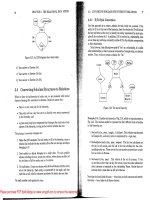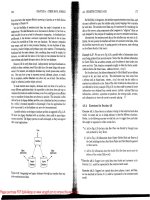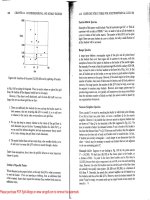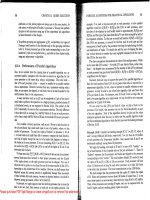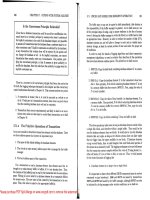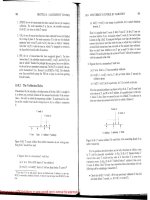The Python Book Rob Mastrodomenico
Bạn đang xem bản rút gọn của tài liệu. Xem và tải ngay bản đầy đủ của tài liệu tại đây (5.05 MB, 258 trang )
The Python Book
The Python Book
Rob Mastrodomenico
Global Sports Statistics
Swindon, United Kingdom
This edition first published 2022
© 2022 John Wiley and Sons Ltd
All rights reserved. No part of this publication may be reproduced, stored in a retrieval system, or
transmitted, in any form or by any means, electronic, mechanical, photocopying, recording or otherwise,
except as permitted by law. Advice on how to obtain permission to reuse material from this title is available
at />The right of Rob Mastrodomenico to be identified as the authors of this work has been asserted in
accordance with law.
Registered Office
John Wiley & Sons, Inc., 111 River Street, Hoboken, NJ 07030, USA
John Wiley & Sons Ltd, The Atrium, Southern Gate, Chichester, West Sussex, PO19 8SQ, UK
Editorial Office
9600 Garsington Road, Oxford, OX4 2DQ, UK
For details of our global editorial offices, customer services, and more information about Wiley products
visit us at www.wiley.com.
Wiley also publishes its books in a variety of electronic formats and by print-on-demand. Some content that
appears in standard print versions of this book may not be available in other formats.
Limit of Liability/Disclaimer of Warranty
The contents of this work are intended to further general scientific research, understanding, and discussion
only and are not intended and should not be relied upon as recommending or promoting scientific method,
diagnosis, or treatment by physicians for any particular patient. In view of ongoing research, equipment
modifications, changes in governmental regulations, and the constant flow of information relating to the
use of medicines, equipment, and devices, the reader is urged to review and evaluate the information
provided in the package insert or instructions for each medicine, equipment, or device for, among other
things, any changes in the instructions or indication of usage and for added warnings and precautions.
While the publisher and authors have used their best efforts in preparing this work, they make no
representations or warranties with respect to the accuracy or completeness of the contents of this work and
specifically disclaim all warranties, including without limitation any implied warranties of merchantability
or fitness for a particular purpose. No warranty may be created or extended by sales representatives, written
sales materials or promotional statements for this work. The fact that an organization, website, or product
is referred to in this work as a citation and/or potential source of further information does not mean that
the publisher and authors endorse the information or services the organization, website, or product may
provide or recommendations it may make. This work is sold with the understanding that the publisher is
not engaged in rendering professional services. The advice and strategies contained herein may not be
suitable for your situation. You should consult with a specialist where appropriate. Further, readers should
be aware that websites listed in this work may have changed or disappeared between when this work was
written and when it is read. Neither the publisher nor authors shall be liable for any loss of profit or any
other commercial damages, including but not limited to special, incidental, consequential, or other
damages.
Library of Congress Cataloging-in-Publication Data
Names: Mastrodomenico, Rob, author.
Title: The Python book / Rob Mastrodomenico.
Description: Hoboken, NJ : Wiley, 2022. | Includes bibliographical
references and index.
Identifiers: LCCN 2021040056 (print) | LCCN 2021040057 (ebook) | ISBN
9781119573319 (paperback) | ISBN 9781119573395 (adobe pdf) | ISBN
9781119573289 (epub)
Subjects: LCSH: Python (Computer program language)
Classification: LCC QA76.73.P98 M379 2022 (print) | LCC QA76.73.P98
(ebook) | DDC 005.13/3–dc23
LC record available at />LC ebook record available at />Cover Design: Wiley
Cover Image: © shuoshu/Getty Images
Set in 9.5/12.5pt STIXTwoText by Straive, Chennai, India
10 9 8 7 6 5 4 3 2 1
v
Contents
1
Introduction 1
2
Getting Started 3
3
Packages and Builtin Functions
4
Data Types
5
Operators 19
6
Dates 25
7
Lists 29
8
Tuples
9
Dictionaries
10
Sets
11
Loops, if, Else, and While
12
Strings
13
Regular Expressions
14
14.1
14.2
14.3
Dealing with Files
Excel 83
JSON 84
XML 86
15
Functions and Classes 91
11
39
41
47
67
73
79
57
7
vi
Contents
16
16.1
16.2
16.3
16.4
16.5
16.6
16.7
16.8
Pandas 103
Numpy Arrays 103
Series 106
DataFrames 111
Merge, Join, and Concatenation 121
DataFrame Methods 136
Missing Data 141
Grouping 146
Reading in Files with Pandas 154
17
17.1
17.2
17.3
Plotting 159
Pandas 159
Matplotlib 169
Seaborn 179
18
APIs in Python 215
19
19.1
19.2
Web Scraping in Python 229
An Introduction to HTML 229
Web Scraping 233
20
Conclusion 255
Index 257
1
1
Introduction
Welcome to The Python Book, over the following pages you will be given an insight into
the Python language. The genesis of this book has come from my experience of using and
more importantly teaching Python over the last 10 years. With my background as a Data
Scientist, I have used a number of different programming languages over the course of my
career and Python being the one that has stuck with me. Why Python? For me I enjoy
Python because its fast to develop with and covers many different application allowing me to
use Python for pretty much everything. However for you the reader, Python is a great choice
of language to learn as its easy to pick up and fast to get going with which means that for the
novice programmers they can feel like they are making progress. This book is not just for
complete novices, if you have some experience with Python, then this book is a great reference. The fact that you can pick up Python quickly means that many users skip the basics.
This book looks to cover all the basics giving you the building blocks to do great things with
the language. What this book is not intended to do is over complicating anything. Python
is beautiful in its simplicity and this book looks to stick to that approach. Concepts will be
explained in simple terms and examples will be used to show how to practically use the
introduced concepts.
Now having discussed what this book is intended to do, what is Python? Simply put
Python is a programming language, its general purpose meaning that it can do lots of things.
In this book, we will specialise in applying Python to data-driven applications, however
Python can be used for many other applications including AI, machine learning, web
development, to name just a few. The language itself is of high level and also interpreted
meaning that code need not be compiled before running. One of the big attractions to the
language is the simplicity of its syntax, which makes it great to learn and even better to
write code. Aside from the clear, easy to understand syntax, the language makes use of
indentation as an important tool to distinguish different elements of the code. Python is
an object-orientated language and we will demonstrate this in more detail throughout
this book. However, you can write Python code how you prefer be it object orientated,
functional or interactively. The best way to demonstrate Python is by doing, so let’s get
started but to do so we need to get Python installed.
The Python Book, First Edition. Rob Mastrodomenico.
© 2022 John Wiley & Sons Ltd. Published 2022 by John Wiley & Sons Ltd.
3
2
Getting Started
For the purposes of this book, we want you to install the Anaconda distribution of Python
that is available at . Here, you have distributions for Windows,
Mac, and Linux, which can be easily installed on your computer. Once you have the
Anaconda installed, you will have access to the Anaconda navigator as shown in
Figure 2.1.
Here, you get the following included by default:
●
●
●
●
JupyterLab
Notebook
Qt Console
Spyder
To follow the examples within this book you can use the Notebook or Qt Console.
The Notebook is an interactive web based editor as shown in Figure 2.2.
Here, you can type your code, run the command, and then see the result, which is a nice
way to work and is very popular. Here, we will show how we can define a variable x and
then just type x and run the command with the run button to show the result (Figure 2.3).
However for the purposes of the book we will use a console-based view that you can easily
obtain through the Qt Console. An example is shown in Figure 2.4.
Like with the notebook, we show the same example using Qt Console in Figure 2.5.
Within this book we will denote anything that is an input with >>> and with any output
having no arrows preceding it (Figure 2.6).
Another concept that the reader will need to be familiar with is the ability to navigate
using the terminal (linux systems including mac) or command prompt (windows). These
can be obtained through various approaches but simply using the search procedures with
the word terminal or command prompt will bring up the relevant screen. To navigate
through the file system you can use the command cd to change directory. This essentially
is like us clicking on a folder to see what is in it. Unlike using a file viewing interface
you cannot see what is in a given directory by default so to do so you need to use the
command ls. This command lists the files and directories within the current locations. Let’s
demonstrate with an example of navigating to a directory and then running a python file.
Aside from the Anaconda navigator we have over 250 open-source data science and
machine learning packages are automatically installed. You can also make use of the
conda installer to install over 7500 packages easily into Python. A full list of packages
The Python Book, First Edition. Rob Mastrodomenico.
© 2022 John Wiley & Sons Ltd. Published 2022 by John Wiley & Sons Ltd.
Figure 2.1
Anaconda navigator.
2 Getting Started
Figure 2.2
Jupyter Notebook.
Figure 2.3
Jupyter Notebook example.
Figure 2.4
Qt Console.
5
6
2 Getting Started
Figure 2.5
Qt Console example.
Figure 2.6
Command line example.
that come with Anaconda is available for the relevant operating system from https://repo
.anaconda.com/pkgs/. Details on the using the conda installer is available from https://
docs.anaconda.com/anaconda/user-guide/tasks/install-packages/ however this is outside
the scope of this book. The last concept we will raise but not cover in detail is that of virtual
environments. This concept is where the user develops in an isolated Python environment
and adds packages as needed. It is a very popular approach to development however as
this book is aimed at beginners we use all packages included in the Anaconda installation.
7
3
Packages and Builtin Functions
We have discussed packages without really describing what they are so let’s look at packages
and how it sits within the general setup of Python. As mentioned previously, Python is
object orientated which means that everything is an object, you’ll get to understand this in
practice, however there are a few important builtin functions which aren’t objects and they
are worth mentioning here as they will be used within the book. These builtin types will be
used throughout the book so keep an eye out for them. Below we show some useful ones,
for a full list refer to />●
dir(): This function takes in an object and returns the _dir_() of that object giving us the
attributes of the object.
>>> name = 'Rob'
>>> dir(name)
['__add__', '__class__', '__contains__', '__delattr__', '__dir__', '__doc__',
'__eq__', '__format__', '__ge__', '__getattribute__', '__getitem__',
'__getnewargs__', '__gt__', '__hash__', '__init__', '__init_subclass__',
'__iter__', '__le__', '__len__', '__lt__', '__mod__', '__mul__', '__ne__',
'__new__', '__reduce__', '__reduce_ex__', '__repr__', '__rmod__',
'__rmul__', '__setattr__', '__sizeof__', '__str__', '__subclasshook__',
'capitalize', 'casefold', 'center', 'count', 'encode', 'endswith',
'expandtabs', 'find', 'format', 'format_map', 'index', 'isalnum', 'isalpha',
'isascii', 'isdecimal', 'isdigit', 'isidentifier', 'islower', 'isnumeric',
'isprintable', 'isspace', 'istitle', 'isupper', 'join', 'ljust', 'lower',
'lstrip', 'maketrans', 'partition', 'replace', 'rfind', 'rindex', 'rjust',
'rpartition', 'rsplit', 'rstrip', 'split', 'splitlines', 'startswith',
'strip', 'swapcase', 'title', 'translate', 'upper', 'zfill']
●
float(): Returns a floating point number from an integer of string
>>> x = '1'
>>> float(1)
1.0
●
int(): Returns an integer from a float of string
>>> x = '1'
>>> int(1)
1
The Python Book, First Edition. Rob Mastrodomenico.
© 2022 John Wiley & Sons Ltd. Published 2022 by John Wiley & Sons Ltd.
8
3 Packages and Builtin Functions
●
len(): Returns the length of an object
>>>
>>>
3
>>>
>>>
4
●
name = 'Rob'
len(name)
x = [1, 2, 3, 4]
len(x)
list(): Creates a list from the argument given
>>> name = 'rob'
>>> list(name)
['r', 'o', 'b']
●
max(): Gives the maximum value from the argument provided
>>>
>>>
4
>>>
>>>
'r'
●
name = ['r', 'o', 'b']
max(name)
min(): Gives the minimum value from the argument provided
>>>
>>>
1
>>>
>>>
'b'
●
x = [1, 2, 3, 4]
max(x)
x = [1, 2, 3, 4]
min(x)
name = ['r', 'o', 'b']
min(name)
print(): Prints the object to the text stream
>>> x = [1, 2, 3, 4]
>>> print(x)
[1, 2, 3, 4]
●
round(): Rounds the number to a specified precision
>>> y = 1.387668
>>> round(y,2)
1.39
●
str(): Converts the object to type string
>>> y = 1.387668
>>> str(y)
'1.387668'
3 Packages and Builtin Functions
●
type(): Returns the type of an object
>>> y = 1.387668
>>> type(y)
<class 'float'>
●
abs(): Returns the absolute value of a numeric value passed in
>>> z = -0.657
>>> abs(z)
0.657
●
help(): Gives access to the Python help system
>>> help(list)
Help on class list in module builtins:
class list(object)
| list(iterable=(), /)
|
| Built-in mutable sequence.
|
| If no argument is given, the constructor creates a new empty list.
| The argument must be an iterable if specified.
|
| Methods defined here:
|
| __add__(self, value, /)
|
Return self+value.
|
| __contains__(self, key, /)
|
Return key in self.
|
| __delitem__(self, key, /)
|
Delete self[key].
|
| __eq__(self, value, /)
|
Return self==value.
Now if you are unfamiliar with the Python the concepts used above they will be introduced throughout this book.
Alongside these builtin functions Python also comes with a number of packages. These
packages perform specific tasks and are imported into our code. Python has a number of
packages that come as default however there are lots of third-party packages which we can
also use. In using the Anaconda distribution we get all the default packages as well as the
packages that are described previously. We will cover both default and third-party packages
throughout this book. To demonstrate this we will introduce how to import a package. The
package we are going to introduce is datetime which is part of the standard Python library.
What this means is it comes with the Python and is not developed by a third party. Now to
import the datetime package you just need to type the following:
>>> import datetime
9
10
3 Packages and Builtin Functions
In doing this we now have access to everything within datetime and to see what datetime contains we can run the built in function dir which as we showed earlier gives us the
attribute of the object.
>>> import datetime
>>> dir(datetime)
['MAXYEAR', 'MINYEAR', '__builtins__', '__cached__', '__doc__', '__file__',
'__loader__', '__name__', '__package__', '__spec__', 'date', 'datetime',
'datetime_CAPI', 'sys', 'time', 'timedelta', 'timezone', 'tzinfo']
Now if we want to see what these attributes are we use the dot syntax to access attributes
of the object. So to see what MINYEAR and MAXYEAR are we can do so as follows.
>>> import datetime
>>> datetime.MAXYEAR
9999
>>> datetime.MINYEAR
1
Now we can import specific parts of a package by using the from syntax as demonstrate
below.
>>> from datetime import date
So what this says is from the package datetime import the specific date attribute. This is
then the only aspect of datetime that we have access to. This is good practice to only import
what you need from a package. Now every time we want to use date we have to call date, in
this case its easy enough but you can also give the import an alias which can reduce your
code down.
>>> from datetime import date as d
That is the basics of importing packages, throughout this book we will import from
various packages as well as show how this same syntax can be used to import our own
code. Alongside builtin functions these are key concepts that we will use extensively within
this book.
11
4
Data Types
The next concept of Python that we will introduce is data types and in this chapter we
will introduce a number of these and show how they behave when applied to some basic
operators. We first start by introducing integers which are a number without a decimal
point, written as follows:
>>> 1
1
>>> 2
2
A float is by definition a floating point number so we can write the previous as follows:
>>> 1.0
1.0
>>> 2.0
2.0
A string is simply something enclosed in either a double or single quote. So again we can
rewrite what we have seen as follows:
>>> "2.0"
'2.0'
Given the fact that we know how to define these variables, how can we check what they
are? Well, conveniently Python has a type method that will allow us to determine the type
of a variable. So we will rewrite what we have done and assign each instance to a variable
and then see what type Python thinks they are
>>> = 1
>>> type(x)
<class "int">
>>> y = 1.0
>>> type(y)
<class "float">
>>> z = "1.0"
>>> type(z)
<class "str">
The Python Book, First Edition. Rob Mastrodomenico.
© 2022 John Wiley & Sons Ltd. Published 2022 by John Wiley & Sons Ltd.
12
4 Data Types
So now we can define the variables, the question is what can we do with them? Initially
we will consider the following operations:
●
●
●
●
+
−
*
/
These are commonly known as the mathematical operation: addition, subtraction,
multiplication, and division.
So let’s start with + now if we have two integers applying + is mathematical addition as
we will show
>>> x = 10
>>> y = 16
>>> x + y
26
Similarly if we do the same with two floats we get a similar result
>>> x = 10.0
>>> y = 16.0
>>> x + y
26.0
But what happens if we apply addition to a float and an integer, let’s see
>>> x = 10
>>> y = 16.0
>>> z = x + y
>>> z
26.0
>>> type(z)
<class "float">
What we see is that addition works on a float and an integer but it returns a float, so it’s
converting the integer into a float.
What if we use addition on a string? Well this is the interesting part, let’s run the same
example from before with x and y as string representations.
>>> x = "10"
>>> y = "16.0"
>>> z = x + y
>>> z
"1016.0"
4 Data Types
What has happened here? Well we have stuck together x and y, this is known as concatenation and is a very powerful tool in dealing with strings.
We considered the + operation with integers and floats but what will happen if we do the
+ operation with a string and say an integer
>>> x = "10"
>>> y = 16
>>> z = x + y
Traceback (most recent call last):
File "<stdin>", line 1, in <module>
TypeError: must be str, not float
What we see here is an error message saying we cannot concatenate a str and int object.
So Python in this instance wants to use the + operation as concatenation but due to the fact
it doesn’t have two strings it can’t do that and hence throws an error. In Python you cannot
mix a string and integer or string and float so we won’t consider operations between these
types for the rest of this section.
Let us now look at the − operation. First considering two integers we get the following:
>>>
>>>
>>>
>>>
-6
x = 10
y = 16
z = x - y
z
As you may have expected the − operation with two integers acts as mathematical subtraction. If we apply it to two floats, or to a mix of floats and integers it acts as subtraction.
What about for strings, can we apply − to two strings?
>>> x = "10"
>>> y = "16"
>>> z = x - y
Traceback (most recent call last):
File "<stdin>", line 1, in <module>
TypeError: unsupported operand type(s) for -: 'str' and 'str'
Here we get another error but this time it is because the − operation doesn’t support
strings. What this means is that when you try to operate on two strings using this operation,
it doesn’t know what to do. The same is true for * and / operations on string. So, if we
are dealing with strings the only operation from this section that we can use is + which is
concatenation.
The next operation we will consider is * which is generally known as mathematical
multiplication to most. So considering its use on two integers we get the following:
>>> x = 10
>>> y = 16
>>> x * y
160
13
14
4 Data Types
As we can see its mathematical multiplication, the same is true when we run the same
on two floats. Let us see what happens when we mix floats and integers.
>>> x = 10
>>> y = 16.0
>>> x * y
160.0
As we can see it returns multiplication in float format, so like with addition and subtraction it converts integers to floats.
Next, we need to see how / operation works on integers and floats, so first we consider
the same types, so we will apply / on integers:
>>> x = 10
>>> y = 16
>>> x / y
0.625
There are other data types beyond these and the first we consider are complex numbers
which can be defined as follows
>>> x = 3+5j
>>> x
(3+5j)
>>> y = 5j
>>> y
5j
>>> z = -5j
>>> z
(-0-5j)
We can obtain the real and imaginary parts of our complex numbers as follows
>>> x.real
3.0
>>> x.imag
5.0
>>> y.real
0.0
>>> y.imag
5.0
>>> z.real
-0.0
>>> z.imag
-5.0
4 Data Types
We can also use the built-in function complex
>>> a = 3
>>> b = 5
>>> c = complex(a, b)
>>> c
(3+5j)
>>> c.real
3.0
>>> c.imag
5.0
In terms of operation we can use the standard operators shown earlier to complex numbers and the results are as follows
>>> x = 3+5j
>>> x
(3+5j)
>>> y = 5j
>>> y
5j
>>> z = -5j
>>> z
(-0-5j)
>>> x + y
(3+10j)
>>> x - y
(3+0j)
>>> x / y
(1-0.6j)
>>> x * y
(-25+15j)
We can also add, subtract, divide or multiply integers or floats to a complex numbers as
we show
10.2
(13.2+5j)
>>> x - 10
(-7+5j)
>>> x - 10.2
(-7.199999999999999+5j)
>>> x * 10
(30+50j)
>>> x
(3+5j)
15
16
4 Data Types
>>> x * 10.2
(30.599999999999998+51j)
>>> x * 10.2
(30.599999999999998+51j)
>>> x / 10
(0.3+0.5j)
>>> x / 10.2
(0.29411764705882354+0.4901960784313726j)
In adding or subtracting an integer or float with a complex we change only the real part
which is to be expected, however if we multiply or divide we apply that value across both
real and imaginary parts.
Next we look at boolean values in Python, these can be defined using True or False
>>> x = True
>>> x
True
>>> y = False
>>> y
False
Integers or floats can be converted into a boolean using the built-in function bool. This
treats any value as 0 or 0.0 as False and any other value to be True.
>>> x = bool(1)
>>> x
True
>>> y = bool(0.0)
>>> y
False
>>> z = bool(-10)
>>> z
True
Surprisingly we can use the operators in this chapter on boolean variables. The key to
note is that a value of True is evaluated as 1 and False as 0, so you can see examples of this
below.
>>>
>>>
>>>
1
>>>
1
>>>
0
>>>
x = True
y = False
x + y
x - y
x * y
x / y
4 Data Types
Traceback (most recent call last):
File "<stdin>", line 1, in <module>
ZeroDivisionError: division by zero
>>> x = True
>>> y = True
>>> x + y
2
>>> x - y
0
>>> x + y
2
>>> x * y
1
>>> x / y
1.0
>>> x = False
>>> y = False
>>> x + y
0
>>> x - y
0
>>> x * y
0
>>> x / y
Traceback (most recent call last):
File "<stdin>", line 1, in <module>
ZeroDivisionError: division by zero
In most cases the results are as expected considering that we are dealing with 1 or 0 in the
operation. However anytime that we divide by zero we get a ZeroDivisonError so be careful
with zero division.
We can also create byte, byte arrays and memory view objects with the following syntax.
>>> x = b"Hello World"
>>> x
b'Hello World'
>>> y = bytearray(6)
>>> y
bytearray(b'\x00\x00\x00\x00\x00\x00')
>>> z = memoryview(bytes(5))
>>> z
<memory at 0x7fdde6fea348>
We can concatenate byte strings together in the way we have shown with strings
>>> x = b"Hello World"
>>> x
b'Hello World'
17
18
4 Data Types
>>> y = b" My name is Rob"
>>> y
b' My name is Rob'
>>> x + y
b'Hello World My name is Rob'
What we have covered in this chapter is some of the data types in Python and how to
operate on them using standard mathematical methods. One thing to take from this is the
mechanism that Python uses to operate on objects and that is simply look for a method that
can take in the arguments that you pass into it.
19
5
Operators
The previous chapter introduced data types and some basic operators but in this chapter we
build on this by introducing a number of key operators that are important to understand.
As shown in our introductory examples in the previous chapter, we can define a variable as
follows:
>>> x = 2 + 1
>>> x
3
Here, we are assigning the variable x with the result of 1 + 2 so x is 3. Now, if we wanted
to see if the value of x was equal to 3 we would use == which refers to equality.
>>> x = 2 + 1
>>> x == 3
True
We have shown how to test for equality but what about inequality. Well Python has that
sorted as well, instead of using == we use != which is not equals. Using the example from
before we get the following:
>>> x = 2 + 1
>>> x != 3
False
What we have here is the result of an equality statement like this being of type boolean
(True or False).
We can also test to see if something is greater or less than another element.
>>> x
>>> x
False
>>> x
True
>>> x
False
= 2 + 1
> 4
< 4
>= 4
The Python Book, First Edition. Rob Mastrodomenico.
© 2022 John Wiley & Sons Ltd. Published 2022 by John Wiley & Sons Ltd.
20
5 Operators
>>> x >= 3
True
>>> x <= 3
True
Here we have introduced the following tests which takes the value on the left against the
value on the right and tests for
●
●
●
●
> for greater than
< less than
>= greater than or equal to
<= less than or equal to
You can also test for equality using the statement is. Now it is not strictly the same as
using == which we demonstrate earlier. Essentially the difference is that it returns True if
the variables in question points to the same object whilst == returns True if the values are
equal. It is a very subtle difference so you need to be careful with it. A simpler explanation is
that == returns True if the variables being compared are equal, whereas is checks whether
they are the same. The below examples shows the dangers in using is
>>> a
>>> a
True
>>> a
True
>>> a
>>> b
>>> a
False
>>> a
True
= 1
is 1
== 1
= []
= []
is b
== b
In the first instance a is assigned to be 1 and we say is a 1 and it is so we get True returned.
In the second instance we assign a and b to be empty list (we will cover what a list is later)
and we can see we return False with the is statement and True with the equals. The reason
behind this is that they are not the same lists so
>>> a is b
False
However, they are both lists so using the comparison statement == we return True as
they are both empty lists. If we assigned a as a list and b = a we would get the following:
>>> a = []
>>> b = a
>>> a is b
True
5 Operators
The reason being is that b is the same as a so they are the same thing. As with == and
!= we have is not again the != is a test of equality between two variables whereas the Python
statement is not, is a test of identity. A good example of this is when you compare a variable
to the Python Null value denoted as None. Here, the preferred way to write it is
>>> a = 21
>>> a is not None
True
You can override the variable by assigning something to it like we did before
>>>
>>>
1
>>>
>>>
10
x = 1
x
x = 10
x
All pretty simple stuff. Now if we have three variables that we want to assign we can do
it as follows
>>>
>>>
>>>
>>>
1
>>>
2
>>>
3
x = 1
y = 2
z = 3
x
y
z
This is fine to do however it takes up a lot of space so instead you can write your assignment as follows
>>>
>>>
1
>>>
2
>>>
3
x, y, z = 1, 2, 3
x
y
z
This just makes it easier to assign variables and makes your code shorter and hopefully
more readable. Obviously the naming convention I’ve used for the variables isn’t the best
and it makes for better code to give your variables meaningful names as it will help those
who have to go back and read your code.
21

